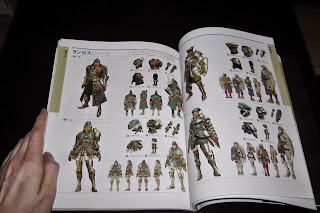The first Monster Hunter Game on PS2 is featured.
This artbooks shows many concept, official and CG artworks. You can see the developement process from sketch ideas / early concepts to official arts over to the CG-3D-Model. All the monster and wyvern seem to be real because of their movement - Creative Director Kaname Fujioka said in a Q&A with the community that they are focusing on the behavior of the monsters to ensure that they are believable - some times the take the leg movement from animal 1, the arm movement from animal b and the head or neck movement from animal c, this may sound like created by Frankenstein's building kit, but in the end it works very well, the monster's physiology and behavior / movement seems possible and looks realistic - if such huge wyvern would exist.
One thing that makes Monster Hunter unique compared to other games in case of armory and weaonry is thefact that the equipment is made out of raw monster material - in other games a wild monster / creature drops a whole armor or money, money call be swallowed be animals but a fullbody armor can't. In MonHun you have to carve the materials like fangs, hides, claws, scales... from the hunted creatures and these materials can be used by your local blacksmith to forge a weapon or armor - this also means that one can see, which monsters you killed, e.g. when wearing a Rathalos armor, It's the same way with the weapon
5 different Armor parts can be equipped - reminds a me a bit of the MegaMan X armors - so there are thousands of different combinations possible.
These pictures with every part being shown separately are perfect for cosplayers
Some of the concepts were not used for the first games like those below. The 2 pictures on top of every page were the first ideas for the called insect glaive in Monster Hunter 4 / 4G (4Ultimate)
And here are very early concepts for the kinsect on the top left corner
That's it for now with the paleontology studies of Hunter's Encyclopedia, i hope you enjoyed it.
See you fellows!















Keine Kommentare:
Kommentar veröffentlichen